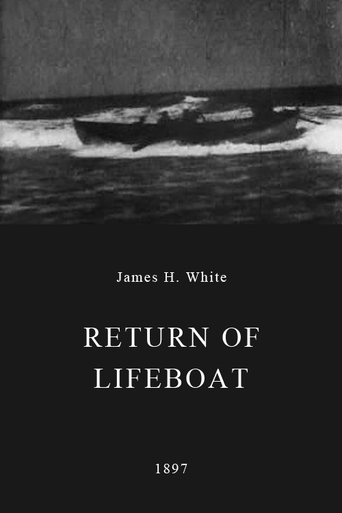Michael_Elliott
Return of Lifeboat (1897) This film clocks in at around twenty seconds and basically delivers exactly what the title says. We see a very choppy sea where a lifeboat tries to reach the shore. There's obviously nothing too ground- breaking here but we do get to see the action from a couple different shots. At such a short running time there's obviously not too much here but it's still mildly entertaining seeing the people in the boat struggle to try and get it on to the shore. There's quite a bit of action in the small running time and it's entertaining for what it is. There's certainly much worse out there.
Horst in Translation (filmreviews@web.de)
The waves are ruthless that day and we see a lifeboat making its way through them fighting a heavy fight in order to avoid being drifted away by the flood and pure force of the waves. Poseidon clearly won't let go easily. There seem to be people in there (God bless their souls), but i guess they're properly trained as they should be for that profession, so the savior won't end up being in need of rescue himself. The short film runs for 25 seconds roughly and honestly,if the title didn't tell me I'd have no idea the boat was actually supposed to be returning to the coast. It just seems to be aimlessly moving in the savage waters and isn't even remotely close to the shore the moment the film ends. Not recommended.
cricket crockett
The reviews for these movies from the 1800s seem written primarily by technocrats intent on gunning for recognition for declaring that this piece or that is the first whatzit or use of thingamabob in the history of the Universe. When one stops to think about it, very few of these "experts" were there, or even talked to someone who was there. Sometimes it's hard to see the forest for the trees. I like to watch these and report to you'll what actually happens in the flick, just like I would MOVIE 43 or any other current release. With that in mind, I can tell you that RETURN OF LIFEBOAT shows about four men making landfall in an 8-12 person boat. What happened to the majority of this ill-fated boat's crew? Were they eaten by the surviving quartet? Were they pushed or forced to jump overboard? Did sharks get them? Why not take 26.71 seconds of your time, watch it NOW for free on the Library of Congress website, and tell us here what YOU think?
Cineanalyst
Two of the most vital developments in early cinema were: the freeing of the camera, which involved the introduction of cameras that could pan and tilt while connected to the tripod, as well as the innovation of placing the camera on moving objects such as boats and trains; the other was the editing. Both gave film numerous new perspectives and possibilities, which would be especially important in the development of narrative movies. This film, "Return of Lifeboat", is an actuality film; it features one of the earliest attempts in motion pictures at presenting multiple perspectives. It's a bit difficult to tell now (and this probably wasn't that steady or flawless of a film to begin with), but this film features both of the aforementioned vital developments."Return of Lifeboat" is the last in a series of seven films that James White and his cameraman Frederick Blechynden took of the Pacific Coast Life Saving Service in San Francisco. In the earlier pictures, the crews perform drills and launch their lifeboats out to sea. This film is the return of one of these lifeboats, with a Captain George H. Varney commanding it. The non-staged action in "Return of Lifeboat" prompted the filmmakers to change the perspective of their camera while filming; it's an impetus that early fiction and staged productions lacked. Apparently, White and Blechynden's camera featured a somewhat unsteady proto panning head, as some jerky camera movement is noticeable in the film. In 1900, White would have a far superior mobile camera head to take pictures at the Paris Exposition, including the tilting in "Panorama of Eiffel Tower".In "Return of Lifeboat", there appear to be about four shots, with the camera moved to different areas for each, as the filmmakers try to attain the best perspective of the returning lifeboat during the rough seas. Filmmakers were already aware of how to edit, but before this film, it seems to have only appeared in a very few tricks films, such as Georges Méliès's "The Vanishing Lady" (Escamotage d'une dame au théâtre Robert Houdin) (1896), and in another Edison film (and perhaps the earliest edit in film history), "The Execution of Mary, Queen of Scots" (1895). An earlier film by White, "Suburban Handicap, 1897", also featured multiple shots. "Return of Lifeboat" may also have been edited in camera by stop-motion; it's hard to say how exactly it was edited. Within a few years, other filmmakers would begin making multi-shot films, including Robert W. Paul in both actuality and narrative in at least two of his 1898 releases: "The Launch of H.M.S. Albion" and "Come Along Do!"Perhaps a reason that "Return of Lifeboat" hasn't received much historical attention for its groundbreaking use of multiple perspectives is how its small, jerky camera pans and quick cuts to different framing function rather harmoniously with the rough seas and the crew's struggle to return to shore. Yet, that's also what makes it exceptional.(Note: This is the ninth in a series of my comments on 10 "firsts" in film history. The other films covered are Traffic Crossing Leeds Bridge (1888), Blacksmith Scene (1893), Annabelle Serpentine Dance (1895), The Execution of Mary, Queen of Scots (1895), La Sortie des usines Lumière (1895), L' Arroseur arose (1895), L' Arrivée d'un train à La Ciotat (1896), Panorama du Grand Canal vu d'un bateau (1896) and Panorama of Eiffel Tower (1900).)


 AD
AD
